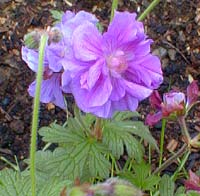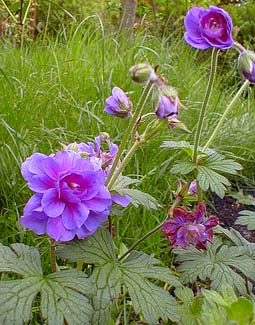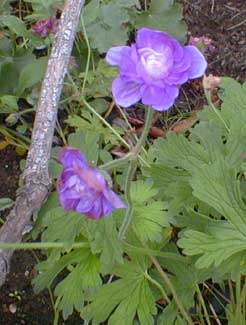
'Lilac Plenum' Crane's-bill; aka
Double Himalayen Hardy Geranium
"My house was called
the house of flowers, because in every cranny
geraniums burst."
-Pablo Neruda
(1904-1973)
(1904-1973)
This clumping perennial is more compact & restrained, & less sprawling than the majority of hardy geraniums. The species spreads by a dense underground root system, but 'Plenum Caeruleum' does so more slowly than the species, even if over time it certainly can colonize an extensive area.
 Ours is planted just inside the dripline under Rhododendron 'Catawba Album' where its pale purple-blue blossoms are a fine counterpoint to the rhody's white blooms in May, & lends continuing color to the area when the rhody is finished blooming.
Ours is planted just inside the dripline under Rhododendron 'Catawba Album' where its pale purple-blue blossoms are a fine counterpoint to the rhody's white blooms in May, & lends continuing color to the area when the rhody is finished blooming.Two clumps butt up against a clump of Chocolate Cosmos, the maroon-black blooms of which rise high above the crane's-bill. The blossoms of both the Chocolate Cosmos & the Lilac Plenum crane's-bill are very long-lasting.
A clump is on average a foot to eighteen inches high, & can spread eighteen inches to two feet, though eventually spreading much wider. The flowers are sterile, hence it will not self-seed, though easily propagated by division.
It is one of the very few double-flower crane's-bills. The ruffled doubles are a light purple or lilac-blue with a fuchsia heart, occurring in pairs & trios for quite a heavily floral effect.
These pompoms resemble old-fashioned roses or double-primroses, so if one's collection of crane's-bill species has begun to seem a bit too similar one planting to the next, here's one that will be extravagant in its differentness.
 The majority of mutated perennials that produce double-blossoms have extremely long-lasting flowers due to their sterility. The fluffy flowers of 'Plenum Caeruleum' hold on & hold on, hoping to be pollinated, but they never can be.
The majority of mutated perennials that produce double-blossoms have extremely long-lasting flowers due to their sterility. The fluffy flowers of 'Plenum Caeruleum' hold on & hold on, hoping to be pollinated, but they never can be.The combination of long-lasting individiual blooms & persistant rebloom from May through the entirety of summer & into Autumn means flowers, flowers, flowers on this marvelous perennial. The photos on this page were taken in May (first & second photo) & in September. It was still flowering in October.
I liked this variety so much that it induced me to keep an eye out for other types of doubles in the future. There are only a few double-geraniums in cultivation, but others include G. x oxonianum 'Southcombe Double,' G. maculatum 'Plenum,' & at least four G. pratense double varieties: 'Plenum Album,' 'Plenum Caeruleum,' 'Plenum Violacium,' plus a new mauve-pink cultivar marketed as 'Summer Skies' Crane's-bill though properly G. pratense x himalayense 'Gernic.'
As for G. himalayense, it has (besides the lavender or lilac-blue 'Plenum Caeruleum' which we have) another strain which is rich rose-pink, sometimes called 'Birch's Double,' though both color varieties are often just called 'Plenum' so to get both colors means watching for them offered for sale in flower to compare. The rose-pink 'Birch's Double' is even more like an old-fashioned rose than is the lilac-blue 'Plenum Caeruleum.'
'Lilac Plenum' aka 'Plenum Caeruleum' is best for USDA zones 4 through 7. Here in zone 8 it needs protection from direct morning sun, & prefers dappled sunlight for the afternoon; given the right degree of shade, it will be fine. In chillier zones it can take a great deal of sun especially in the afternoon.
A few gardeners kvetching on bulletin boards & in newsgroups have reported their Himalayan hardy geranium rotted in moist soil, or else shrivelling away in dry soil. Though it seems as hardy as less fancy varieties to me, I have to take these complaints at face value, & some overviews of 'Lilac Plenum' do indicate it is somewhat sensitive above Zone 7. But it really oughtn't be a problem if moist soil is well-draining, or if it grows from out of the roots of a large woody shrub that keeps the soil from staying overly wet for long at a time. If there is some problem of excess moisture because of clayey soil, 'Plenum Caeruleum' can be placed atop a humped up mound of soil that will drain properly.